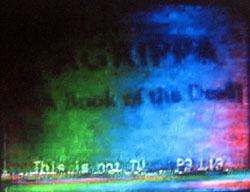Archival Documents »The “Hack”
Bootleg Video of “Transmission” Event at the Americas Society, With Live Run of the Diskette Containing William Gibson’s “Agrippa” (9 December 1992)
This video, approximately one hour long, was made surreptiously by “Templar,” the pseudonym of one member of a graduate-student team known as “Templar, Rosehammer, and Pseudophred” from New York University’s Interactive Television Program. The team had been recruited to shoot the screen of a laptop computer used by Kevin Begos, Jr. (the publisher of Agrippa) for the public unveiling of Agrippa at the Americas Society, New York City, on December 9, 1992 (during the so-called “Transmission” event). Their sanctioned mission was to project on a large screen the laptop’s image of a complete, live “run” of William Gibson’s poem (running from Agrippa’s diskette). Unbeknownst to the event’s organizers, however, Templar had slotted a blank video cassette into the camera used for the live feed. The resulting recording is presented here from a copy of the original videotape (the original has not been found) recovered in 2007 by “Rosehammer” from a ¾ video tape cartridge (in NTSC format) labeled “AGRIPPA—[Templar’s] VIEW.” Highlights of the recording include:
- Interview of Kevin Begos, Jr. by Karen Benfield, producer for the Wall Street Journal Television Report (approx. 20 minutes).
- The “run” of Gibson’s poem scrolling up the screen of Begos’s laptop, accompanied by a synchronized audio recording of comedian Penn Jilette reading the text (approx. 20 minutes).
- Question and answer period with Begos, cut off unexpectedly when someone approached Templar and caused him to stop recording to prevent discovery.
For detailed discussion of this video and related events, see on this site Matthew G. Kirschenbaum’s “No Round Trip: Two New Primary Sources for Agrippa“ (as well as the earlier excerpt from his book, Mechanisms: New Media and the Forensic Imagination (MIT Press, 2008). Of related interest: Re:Agrippa, an experimental video composition made by Rosehammer and Templar in 1993 that samples and remixes selected footage from the 1992 bootleg video, and adds experimental-video-style montage, sound, and titling effects.
Video Cartridge with ¾” Tape Copy of Bootleg Video of “Transmission” Event at the Americas Society, New York City (December 9, 1992)
| Item #D49. Video cartridge containing ¾”-tape copy of the bootleg video of “Transmission” event at the Americas Society, New York Society. (Basis of Item #D48 on this site; original video recorded 9 Dec. 1992; date of this video cartridge and its copy of the original tape unknown) Note that the front cover of the box for the cartridge bears a label for the 1993 Re:Agrippa remix of the tape by the pseudonymous “Rosehammer,” while the label on the cartridge itself refers to his partner “Templar’s” camera view at the original, 1992 Americas Society event. |
Re:Agrippa (Experimental Video Based on Footage of Dec. 9, 1992, From One of the Sites of the ‘Transmission’ of Agrippa) (1993)
 |
Item #D16. Experimental video Re:Agrippa by “Rosehammer & Templar” (probably specifically Rosehammer) (produced 1993), based originally on bootleg video from a Dec. 9, 1992, public screening of the “Agrippa” poem. |
|
|
Re:Agrippa is an experimental video composition that samples and remixes (with added material) footage from a bootleg video recorded at the public unveiling of Agrippa at the Americas Society in New York City (one of the sites of the “Transmission”). The footage that Re:Agrippa includes from the original bootleg video (now available in full as Item #D48 on this site) shows the text of William Gibson’s poem in Agrippa scrolling up the screen, accompanied by a soundtrack of Penn Jillette reading from the poem; shots of publisher Kevin Begos, Jr., introducing the work; and added experimental-video-like montage, sound, and titling effects added by Re:Agrippa’s pseudonymous makers. (A transcription of the full bootleg video underlies the so-called “hacking” of the poem and its release to the Internet on Dec. 10, 1992. See “-Templar- Rosehammer & Pseudophred’s” introduction to the text of the poem that appeared on that date on the MindVox BBS; see also Matthew G. Kirschenbaum’s discussion and follow-up discussion of various explanations of “the hack.”)
For Windows Users (WMV9, streaming)
» Excerpt: Gibson’s poem scrolling up screen (.wmv, 20 secs.) » Full video (.wmv, 5 min., 32Mb)
For Macintosh Users (Quicktime 7, streaming)
» Excerpt: Gibson’s poem scrolling up screen (.mov, 20 secs.) » Full video (.mov, 5 min., 27Mb) Note: The Windows Quicktime plug-in for IE and Firefox is flawed and may crash when streaming Quicktime 7 (H.264) content. Windows users are encouraged to view the WMV files above or download the Quicktime files prior to viewing (rather than streaming).
|
||
‘Templar’s’ Introduction to the First Online Copy of Gibson’s ‘Agrippa’ Poem (December 10, 1992)
Item #D44. Introduction by “Templar” to the First Online Copy of William Gibson’s “Agrippa” poem
This introduction, which claims that the code of the Agrippa diskette was “hacked & cracked,” announced the first version of Gibson’s poem posted online (to the MindVox BBS) on Dec. 10, 1992. The transcript here is from a now defunct Web page version of the MindVox posting available until early 2005 at http://riverbbs.net/pub4/ebook/Agripp.Txt (currently available only in the Google cache here) For the way the poem leaked online and different views about whether it was ever actually hacked, see Matthew G. Kirschenbaum’s discussion and follow-up discussion. See also the bootleg video recorded at the Dec. 9, 1992, “transmission” event at the Americas Society in New York City, as well as the 1993 experimental video Re:Agrippa based on the bootleg footage. (One theory was that transcribing from this footage may be the low-tech way the poem was hacked. Subsequent evidence, including the discovery of the original bootleg video recorded Dec. 9, 1992, at the Americas Society and correspondence with Templar’s partner video maker, “Rosehammer,” confirms this theory.)











